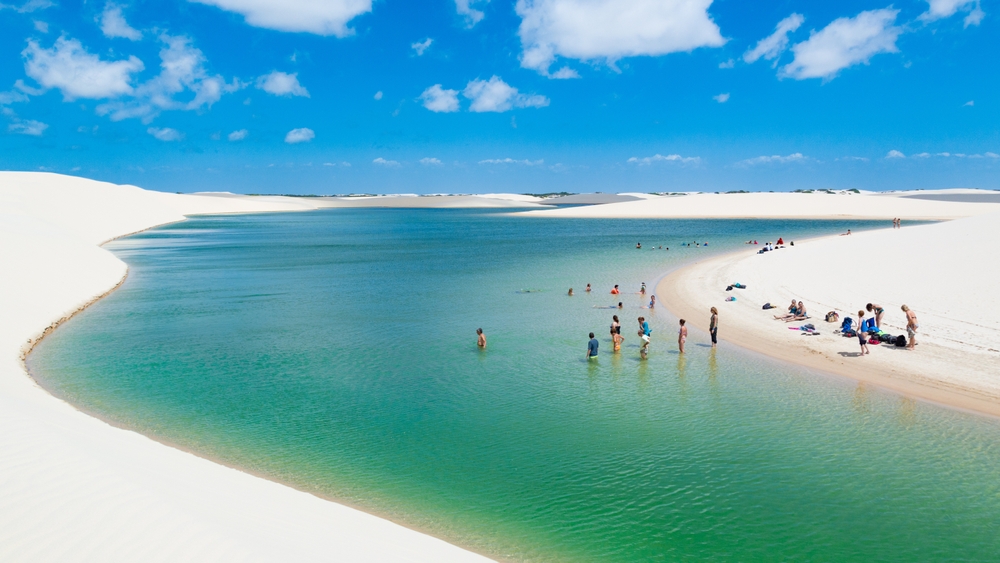Lençóis Maranhenses National Park, located in Maranhão state in northeastern Brazil, is a breathtaking natural wonder, attracting travelers from all around the globe. Established on June 2, 1981, this 155,000-hectare (380,000-acre) park encompasses 70 kilometers (43 miles) of coastal area and features a unique landscape with rolling sand dunes. The park is a dynamic ecosystem that has created stunning contrasts between the white sand dunes and the rainwater-filled lagoons that form at certain times of the year.
The Portuguese name for the park, “lençóis,” translates to “bedsheets” in English, which aptly describes the endless expanses of dunes that appear to stretch like a vast sea of white linen. The park’s extraordinary terrain not only offers an awe-inspiring visual spectacle, but also supports diverse wildlife species, including migratory birds, turtles, and various fish species in the temporary lagoons. Visitors can explore this natural gem by embarking on various activities such as trekking, horseback riding, and off-road vehicle adventures.
Often referred to as one of Brazil’s top natural attractions, Lençóis Maranhenses National Park holds a breathtaking allure for those who seek a truly unique and unforgettable travel experience. Its mesmerizing sand dunes and cerulean lagoons beckon adventurers to witness the unparalleled beauty of this extraordinary destination, which continues to captivate the hearts of those who venture to this corner of the world.
Table of Content
ToggleGeography and Location
Lençóis Maranhenses National Park is a breathtaking protected area located in the northeastern State of Maranhão, Brazil. Covering an area of 155,000 hectares, the park lies just east of the Baía de São José and spans across 70 km of coastline.
This extraordinary national park showcases a unique landscape that captures the essence of Brazil’s beauty. The park is characterized by its rolling sand dunes, which are the largest field of dunes in South America. The incredible sand dunes are interspersed with crystal-clear lagoons, creating a mesmerizing sight.
The topography of Lençóis Maranhenses National Park is primarily composed of mobile dunes and the captivating lagoons formed within them. These dunes, which can be as tall as 40 meters, shift and change with the winds, adding to the dynamic nature of this stunning location.
The national park is situated in a remote part of the coast in Maranhão, making it lesser known and visited, compared to some of Brazil’s other attractions. Its isolation, however, only adds to the sense of adventure and wonder that awaits visitors to this remarkable destination.
In summary, Lençóis Maranhenses National Park showcases the astonishing beauty and rich geological features of Brazil’s northeastern coast. As a vast landscape featuring rolling dunes, pristine lagoons, and a protected coastal region, it is a must-visit for anyone seeking to discover the diverse wonders of Maranhão and the country’s northeastern frontier.

The National Park
Lençóis Maranhenses National Park, also known as Parque Nacional dos Lençóis Maranhenses, is a unique and breathtaking national park located in the Maranhão state of northeastern Brazil. Established in 1981, the park spans over 155,000 hectares (380,000 acres) and includes 70 kilometers (43 miles) of coastline, making it one of the country’s top natural attractions.
At the heart of the park lies a vast expanse of white sand dunes that seemingly stretch endlessly across the landscape. These dunes are formed by strong winds that constantly shift and sculpt their appearance. During certain times of the year, rainwater fills the valleys between the dunes, creating stunning blue and green lagoons that contrast beautifully with the white sand.
Lençóis Maranhenses National Park is managed by ICMBio, or the Instituto Chico Mendes de Conservação da Biodiversidade. This federal institution is responsible for the park’s conservation and management, ensuring that its unique ecosystem is protected and maintained for future generations to enjoy.
Visitors to the park can take part in various activities, such as guided tours, hiking, and horseback riding. Access to Lençóis Maranhenses National Park is usually through the town of Barreirinhas, where tourists can find lodging and tour operators. It’s essential for visitors to respect the park’s rules and guidelines, as improper behavior can negatively impact the delicate ecosystem.
In summary, Lençóis Maranhenses National Park is a truly exceptional destination, offering a unique blend of striking landscapes and rich biodiversity. Managed by ICMBio, the park is a testimony to Brazil’s dedication to conserving and showcasing its remarkable natural wonders.
Lagoons and Terrain
Lençóis Maranhenses National Park, located in northeastern Brazil, features an extraordinary landscape comprised of vast rolling sand dunes and unique lagoons. The park covers an area of 155,000 hectares with 70 kilometers of coastline. This area can best be described as a desert-like region, but distinct from traditional deserts due to the presence of abundant water sources during specific periods.
The park’s terrain is a product of the region’s climate, with strong winds blowing sand from the interior of the continent towards the Atlantic, creating the vast sand dunes. During the rainy season, typically from July through September, the sand dunes collect rainwater, forming numerous clear blue lagoons that contrast beautifully with the stark white sand dunes.
Several famous lagoons in Lençóis Maranhenses National Park include Lagoa Bonita, Lagoa Do Peixe, Lagoa Azul, Lagoa Da Gaivota, and Lagoa Da Esperança. These lagoons differ in size, depth, and clarity but all offer a unique experience to visitors. The lagoons are home to a variety of fish species that are able to survive in these temporary bodies of water, adding to the uniqueness of the park’s ecosystem.
Despite its arid appearance, Lençóis Maranhenses National Park is not technically a desert. The region receives approximately two meters of rain per year, which is much higher than the average rainfall for a desert. This rainwater contributes to the formation of the stunning lagoons and supports the diverse flora and fauna found within the park.
In conclusion, the unique combination of striking sand dunes and life-sustaining lagoons makes Lençóis Maranhenses National Park a truly remarkable destination. The park’s terrain and the seasonal transformation of its landscape continue to captivate visitors from around the world.
Weather and Climate
Lençóis Maranhenses National Park, located in Maranhão, Brazil, experiences a unique climate that contributes to its captivating landscape. The area’s average annual temperature ranges between 26 °C (79 °F) and 28.5 °C (83.3 °F), with an annual temperature variation of about 1.1 °C (2 °F) 1.
The park’s climate can be broadly divided into two main seasons: the rainy season (Regenzeit) and the dry season (Trockenzeit). The rainy season generally starts in December and lasts until June, bringing abundant rainfall that fills the park’s iconic lagoons. These lagoons are often interconnected, exchanging water with each other and the rivers that run through the area 1.
During the dry season, which typically occurs from July to November, the precipitation is significantly reduced. This causes the lagoons to gradually dry up or shrink, exposing vast expanses of white sand dunes. The difference in temperatures between the seasons is minimal, but the fluctuations in precipitation levels have a substantial impact on the park’s appearance and ecosystem.
A variety of factors contribute to the overall climate in Lençóis Maranhenses National Park, including its proximity to the coast and the influence of the ocean currents. The park sits near the Atlantic Ocean, which moderates the temperatures and contributes to the moisture coming from the rainforests further inland. The wind patterns in the region also play a crucial role in shaping the dune formations, while the ocean currents affect the amount of rainfall received by the park.
In summary, the park’s climate is characterized by relatively stable temperatures throughout the year, with significant variations in precipitation levels and precipitation patterns. This creates a dynamic environment that continually shapes and reshapes the stunning landscape of Lençóis Maranhenses National Park.

Flora and Fauna
Plants
In Lençóis Maranhenses National Park, the flora is distinct and somewhat sparse due to the unique environmental conditions. The most commonly found plants are grasses, which have adapted to the sandy terrain and are crucial for stabilizing the dunes. These grasses play a significant role in holding the sand together and preventing erosion.
In addition to grasses, there are also some cacti and shrubs that have adapted to the arid conditions of the national park. One example of such shrubs is the resilient sandgrass, which has long roots that anchor it deep into the ground, allowing it to survive in an area with almost no water or nutrients.
Animals
The Lençóis Maranhenses National Park is home to a diverse array of animals, which have adapted to the challenging conditions. The park’s temporary lagoons that form during the rainy season are filled with a variety of fish species that manage to survive even in the constantly shifting environment. These fish are an essential food source for other inhabitants of the park such as birds and reptiles.
Turtles are also present in the park, as documented by a study that describes a new turtle species discovered within the park grounds. Moreover, the lagoons host an array of crustaceans like crabs and shrimps, which contribute to the unique ecosystem of Lençóis Maranhenses National Park.
In addition to aquatic life, the park also shelters a variety of mollusks, or weichtiere, which play a key role in the park’s ecosystem by breaking down organic material and providing nutrients for other organisms. Furthermore, the park supports the conservation of the elusive and endangered Oncilla or little spotted cat, a small felid native to Brazil.
Overall, the park’s flora and fauna reflect the unique nature of Lençóis Maranhenses National Park, showcasing the incredible adaptations and resilience of the species that thrive there.

Towns and Surroundings
Lençóis Maranhenses National Park, located in northeastern Brazil, is surrounded by various towns and cities that offer unique experiences for visitors. Each town has its distinct charm and serves as a gateway to the breathtaking park.
Barreirinhas is the main gateway to the national park and a popular starting point for tourists. This town offers various accommodation options, as well as local restaurants and stores for last-minute supplies before venturing into the park.
Atins is a smaller village located on the edge of Lençóis Maranhenses, offering a more laid-back and tranquil experience. While not as developed as Barreirinhas, it still provides basic amenities such as accommodations and dining options. Atins also serves as an ideal base for kitesurfing enthusiasts.
Santo Amaro do Maranhão is another town that provides access to the park. Less touristy but equally charming, this place boasts pristine lagoons and a more authentic experience of local culture.
Caburé and Paulino Neves are small villages nestled between the national park and the ocean. Caburé is known for its sandy beaches, while Paulino Neves is a gateway to the unique “Pequenos Lençóis,” a smaller version of the sand dunes found in Lençóis Maranhenses.
Baixa Grande and Humberto de Campos are remote villages situated within the park itself. Baixa Grande can be reached through a multi-day hike or a 4×4 adventure, while Humberto de Campos is accessible by road. Both villages offer a chance to experience the local way of life amid the sand dunes and lagoons.
Mandacaru is a picturesque fishing village with a famous lighthouse, known as the Farol Preguiças, that offers stunning views of the park and the coast.
Tutóia is a coastal town that serves as a base for trips to the national park, as well as the nearby Delta, do Parnaíba. The town offers various accommodation options, boat tours, and access to beautiful beaches.
Lastly, São Luís is the capital of Maranhão state and the main entry point for travelers coming to the region. The city itself is a UNESCO World Heritage Site, with its well-preserved colonial architecture and vibrant cultural scene.
In summary, there are numerous towns and villages surrounding Lençóis Maranhenses National Park that cater to different preferences and needs. Each town offers a distinct environment and serves as a base for exploration, allowing visitors to immerse themselves in the breathtaking landscape and vibrant local culture.
Transportation and Access
Lençóis Maranhenses National Park is a breathtaking natural attraction located in Maranhão State, Brazil, encompassing around 155,000 hectares of white dunes and freshwater lagoons. To access this stunning park, visitors can choose from various modes of transportation.
One popular way to reach the park is by jeep. Travelers typically embark from Barreirinhas, a nearby town that serves as a gateway to Lençóis Maranhenses. The journey from Barreirinhas to the national park can be done on 4×4 vehicles, which will navigate through sandy terrains and offer a unique, adventurous experience.
Another option for accessing the park involves utilizing a variety of water-based transportation methods, including ferries (Fähre), regularly scheduled ships (Linienschiff), and water taxis (Bootstaxi). These modes of transport provide scenic routes for visitors along Brazil’s northeastern coastline.
Upon arrival at the park, travelers will find well-maintained infrastructure, including visitor centers and designated tour routes. It is important to note that independent exploration within the park is limited, and guided tours are highly recommended for a safe, enjoyable, and informative experience.
To conclude, whether traveling by land or water, accessing Lençóis Maranhenses National Park is easy and offers a range of transportation options, ensuring a memorable journey for all visitors.
Accommodation and Food
Visitors to Lençóis Maranhenses National Park have a variety of accommodation options to choose from. There are no campgrounds or amenities within the park itself, but nearby towns such as Barreirinhas offer various types of lodging, including pousadas, resorts, and hotels.
For those seeking accommodations close to nature, there are lodging options near the park with prices starting from $54. Travelers can also find a selection of great accommodations in Lençóis Maranhenses National Park on Booking.com, with properties such as Porto Preguiças Resort in Barreirinhas.
In addition to pousadas, other options include more upscale hotels and resorts, as well as pensions (Pensionen) and other types of accommodations (Unterkünfte). These accommodations offer various amenities to cater to different preferences and budgets. Some of the top-rated lodging options can be found on TripAdvisor, offering guests amenities such as free Wi-Fi, breakfast, and parking.
When it comes to food options, travelers can find plenty of local cuisine in the surrounding towns near the national park. Barreirinhas, for example, is known for its traditional Brazilian dishes such as feijoada, a hearty stew made of beans and pork, and Moqueca, a delicious seafood stew. There are also a variety of other dining options available, from casual eateries to more sophisticated restaurants catering to international tastes.
In conclusion, visitors to Lençóis Maranhenses National Park have a wide range of accommodation and food options available to them. By staying in nearby towns and exploring local dining options, travelers can fully enjoy their visit to this unique and captivating destination.

Activities and Tours
Lençóis Maranhenses National Park, located in Maranhão State, Brazil, is an awe-inspiring natural attraction covering 383,000 acres of pristine white sand dunes and shimmering lagoons. Offering a range of activities and tours, it is a must-visit destination for travelers seeking outdoor adventures.
Baden, or bathing, is one of the park’s most enjoyable activities. The park’s unique landscape is home to numerous green and blue lagoons, which create mesmerizing oases amidst the vast dunes. Visitors can swim and relax in these lagoons, making it an ideal activity for families and couples alike.
For thrill-seekers and adventure enthusiasts, Ausflüge, or excursions, will not disappoint. The park offers various kinds of tours, such as walking tours and multi-day tours, that cater to different interests and preferences. A skilled guide can accompany travelers on these tours, enriching the experience by providing insights into the park’s unique ecosystem and local flora and fauna.
Jeep tours are another popular option and an excellent way to traverse the park’s challenging terrain. The Lençóis Maranhenses National Park Tour is an exciting 8-hour adventure that includes overland transport in a 4WD vehicle and insightful narrative from a knowledgeable guide.
Reisezeit, or travel time, is crucial when planning a visit to the national park. The best time to visit Lençóis Maranhenses is between May and October when the lagoons are at their peak, offering visitors the chance to truly experience the park’s beauty.
In summary, Lençóis Maranhenses National Park is a captivating Reiseziel, or destination, that provides a wealth of activities and tours for visitors to enjoy. With options such as Baden, Ausflüge, Jeep tours, and picturesque landscapes, it offers a once-in-a-lifetime experience that every traveler should add to their bucket list.
Cultural and Film References
Lençóis Maranhenses National Park has been featured in various films and cultural references that showcase its unique landscape. An example is the Brazilian movie The House of Sand, which was filmed in the park and utilized its ethereal sand dunes and lagoons as part of the narrative. The 2005 film, directed by Andrucha Waddington, tells a multigenerational story of a mother and daughter living in northern Brazil among the dunes.
In Hollywood, the breathtaking scenery of Lençóis Maranhenses was used in two blockbuster Marvel movies: Avengers: Infinity War (2018) and Avengers: Endgame (2019). The park’s dramatic landscape provides the backdrop for the fictional planet Vormir, a remote and desolate world that plays a crucial role in the narrative, as it is the location of the Soul Stone, an essential element in the story.
The choice of Lençóis Maranhenses National Park for these culturally significant films highlights the park’s unforgettable beauty, which remains largely untouched by human intervention. As a result, filmmakers and viewers alike are captivated by the unique, otherworldly charm of its vast sand dunes and seasonal lagoons.
Filming in the park also helps promote Brazil’s rich natural heritage and contributes to raising awareness of the country’s diverse ecological wonders. Moreover, the increased visibility provided by these film productions may benefit local communities, fostering tourism and economic development in the region.
Conservation and Environmental Impact
Lençóis Maranhenses National Park is a unique ecosystem situated in Maranhão State, northeastern Brazil. The park, which stretches over 155,000 hectares, is home to the largest sand dune field in South America and a diverse array of habitats, including mangroves, restinga, and coastal regions 1. Protecting this incredible landscape and the rich wildlife that inhabits it is of paramount importance.
The park’s conservation efforts focus on preserving its various ecosystems such as Rio Negro and the surrounding land. One of the most striking features of Lençóis Maranhenses is the presence of lagoons, formed by seasonal rainfall and the flow of rivers like the Preguiças River and Rio Preguiças 2. These lagoons play a vital role in supporting aquatic and semi-aquatic species, such as fish and amphibians.
In addition, the park’s coastal areas, including the Landzunge and Queimada Do Britos, serve as essential nesting sites for migratory bird species and are crucial for the survival and reproduction of marine turtles. Along the coastlines, the mangroves play a significant role in protecting the land from erosion and supporting various marine species 3.
The park’s unique wanderdünen, or mobile dunes, are in constant motion due to the winds that shape them. These shifting sands create a dynamic landscape, influencing the distribution of flora and fauna within the park. The wandering dunes can sometimes have negative impacts on nearby communities and ecosystems by encroaching on surrounding areas 4. This makes the ongoing efforts to understand and manage the park’s natural processes essential.
To minimize the park’s environmental impact on local ecosystems, various strategies have been proposed, such as conservation with management, management, management and restoration, and restoration 5. These strategies aim to preserve Lençóis Maranhenses National Park’s irreplaceable habitats while also addressing the challenges that arise from human activities within its boundaries.
Footnotes
Frequently Asked Questions
What is the best time to visit Lençóis Maranhenses?
The best time to visit Lençóis Maranhenses National Park is between May and September, during the rainy season. This is when the park’s famous lagoons are at their fullest and most vibrant. However, the park offers unique beauty throughout the year.
How do I get to the park from Rio de Janeiro?
To get to Lençóis Maranhenses from Rio de Janeiro, you would first take a flight to São Luís, the capital of Maranhão state. From São Luís, you can take a bus or arrange for private transport to the town of Barreirinhas, which serves as the gateway to the park. The trip from São Luís to Barreirinhas typically takes about four hours by road.
What makes Lençóis Maranhenses unique?
Lençóis Maranhenses National Park is unique due to its stunning landscape of immense white sand dunes interspersed with crystal-clear freshwater lagoons. These lagoons, formed by rainwater, are at their fullest between May and September. The park’s vast, desert-like expanse, contrasted with the vibrant blue and green lagoons, creates a surreal and breathtaking scene unlike anywhere else in the world.
Are there any nearby attractions like Chapada Diamantina National Park?
While Chapada Diamantina National Park is located in a different state (Bahia), there are several other interesting attractions near Lençóis Maranhenses National Park. The Delta of Parnaíba River, the only open sea delta in the Americas, is a stunning attraction and is roughly a four-hour drive from the park. The city of São Luís itself, with its historic center designated a UNESCO World Heritage Site, is worth exploring as well.
Is the park a UNESCO World Heritage Site?
As of my knowledge cutoff in September 2021, Lençóis Maranhenses National Park is not a UNESCO World Heritage Site. However, it is a highly valued area of natural beauty and ecological significance within Brazil.
What can I expect to see at the lagoons in the park?
In the lagoons of Lençóis Maranhenses, you can expect to see crystal-clear freshwater bodies nestled among the white sand dunes. These lagoons are filled with rainwater, primarily during the rainy season from May to September. You may also see a variety of aquatic life, including fish species that somehow manage to survive even when the lagoons dry out. The contrast between the vibrant lagoons and the vast white dunes provides a striking visual spectacle, making for incredible photo opportunities.












